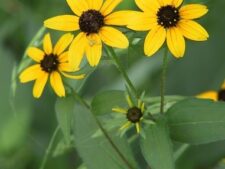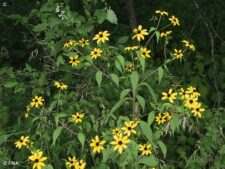
BROWN-EYED SUSAN
Rudbeckia triloba
SUNFLOWER FAMILY (Asteraceae)
 Identification
Identification
- Flowering time - July, August, September, October
- Common in some (not all) prairies at NW
- Bushy, much-branched plant with many flowers
- Flowers smaller than most of our other 'sunflowers'
This native perennial has a rough, hairy, much branched stem to 5 feet tall giving the larger plants a bushy appearance (C). Leaves on the branches are alternate, unstalked, coarsely toothed and lance-shaped (C). Main stem leaves can be up to 4 inches long, sometimes deeply cut into 3 lobes (D). Flower heads 1 1/2 inch wide are abundant on spreading branches. Each head consists of 6-12 spreading, yellow, petal-like ray florets surrounding a rounded to cone-shaped brown disk containing the fertile disk florets (A,B).
Found in moist prairies, woods, thickets and stream banks, flowering from July through October. At Neale Woods, it is common in some (not all) of the prairie restorations.
Smaller flower heads and much branched stems separate brown-eyed Susan from the other Rudbeckias. See Black-eyed Susan (Rudbeckia hirta) for more complete discussion.
The content of NatureSearch is provided by dedicated volunteer Naturalists of Fontenelle Forest who strive to provide the most accurate information available. Contributors of the images retain their copyrights. The point of contact for this page is: Neal Ratzlaff.



